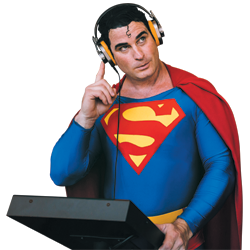presentation staging
 My company is adding a presentation theater to our new exhibit, complete with lighting, staging, multimedia, etc. However, I don't know the first thing about in-booth theaters. What are some tips to help us plan an effective theater space? My company is adding a presentation theater to our new exhibit, complete with lighting, staging, multimedia, etc. However, I don't know the first thing about in-booth theaters. What are some tips to help us plan an effective theater space?
 Exhibit presentations are a great way to relay key messages and product information. Plus, presentations provide attendees with a way to learn about your products without having to commit to a one-on-one demo or even to interact with a salesperson. What's more, in-booth theaters can be a draw in themselves, as weary attendees often appreciate the ability to sit down and relax - while soaking in your messages. Exhibit presentations are a great way to relay key messages and product information. Plus, presentations provide attendees with a way to learn about your products without having to commit to a one-on-one demo or even to interact with a salesperson. What's more, in-booth theaters can be a draw in themselves, as weary attendees often appreciate the ability to sit down and relax - while soaking in your messages.
That said, you can't just plop a theater in your booth space and expect attendees to fill it faster than ants swarm a picnic. Not only must your presentation be top-notch and on par with attendees' needs, but the theater itself must be accessible, inviting, and professional, and its elements - such as lighting, sound, and staging - must support your presentation, not detract from it. So here's the least you need to know about theater setup, including everything from size and location to sound and lighting.
Size Matters
One of the first things to consider about the size of your theater is its importance within your exhibiting strategy. If your theater will be the main attraction in your booth, you'll likely want to devote a large portion of your space to it, visually indicating to attendees that the presentation is a not-to-be-missed event. In addition, ensure that the theater is big enough to accommodate your expected audience. You don't want attendees stuck in the aisles craning their necks to try to catch a glimpse of the presenter.
Keep in mind, however, that a
theater full of people says "interesting" and "on topic;" whereas, a half-empty theater says "boring" and "B list." So while you don't want attendees standing in the aisles to watch your show, you also don't want a ton of empty chairs for every presentation. Finding just the right size theater is critical in terms of attendee perceptions.
The solution is to create a slightly smaller theater than you think you need, but to offer numerous presentations throughout the day. For example,
rather than building a 50-seat theater for three 20-minute presentations per day, consider a 25-seat theater and seven, 10-minute presentations per day, perhaps with varying topics. This way, you'll have a greater chance of a packed house for each show - and an increased likelihood attendees will perceive your company as a hot act, not a has-been.
Location, Location, Location
For any theater that will act as a main component of your strategy, the best location within your space is facing a heavy-traffic aisle. With proper pre-show promotion, some attendees will schedule your presentations into their at-show plans, but an aisle-side presentation theater will often draw passersby into your space just to see what's going on.
If your theater is more of an ancillary element of your booth, then a smaller, perhaps enclosed space off an aisle is a better option. In fact, if you plan to offer presentations to a select audience as opposed to the entire attendee base, consider a theater
located in a back corner of your space or maybe on an upper-level deck for even more privacy.
Also, consider where you expect attendees to go after the presentation. Do you want post-presentation traffic to flow back into the aisles? Or do you want people to have easy access to product areas and salespeople? There are various ways to direct this traffic, such as verbal instructions from a presenter, carpet inlays, a carefully directed spotlight, etc. But the time to consider post-presentation traffic flow is when you're plotting the location of your theater within your space - not when your theater is making its debut on the show floor.
Light it Up
Just as lighting is important to overall exhibit visibility, it's equally important to highlight key components within your theater, including everything from your presenter and your products to a cirque-style performer dangling overhead. So just about every exhibit theater should have some lighting built into the design, even if it's just to highlight your company logo across the top of the stage.
To ensure your in-booth theater has the lighting it needs, ask yourself the following questions: Do I need to highlight messaging or a specific product? Will there be speaker, topic, or activity changes for which transitional lighting is appropriate? Should I add a color wash to the back wall or the entire space to draw attention to the theater and add a touch of color and flair? Would programmable, moving lighting add to - or detract from - the presentation?
Also note that each component you add takes up space - horizontally within your floor plan and/or vertically
over your footprint. It's not that the lighting and the truss upon which its rigged takes up oodles of floor space, but rather that you must consider this extra space during the design phase of your theater and plan it into your installation schedule.
Can You Hear Me Now?
Anyone that has ever attended an exhibition knows that the show floor can be a loud, almost raucous environment. Not surprisingly, then, sound control is a critical aspect of every theater. Not only do you need to monitor the sounds associated with your presentation, and ensure that your presenter doesn't detract from other conversations or activities happening in the booth, but often, you must also attempt to block out the ambient sounds of the show.
Certainly, a quality sound system is a must for your theater. However, depending on the size of your theater and the type of presentation you plan to offer, a "quality system" could include multiple monitors and mixers, or it could simply be one high-quality, squeal-free microphone.
Aside from the sound system, the location of the theater and the direction it's facing have a big impact on sound control. Pointing your presentation stage into your booth - so that your seated attendees are near the center of your space and facing the aisle - helps isolate them from exterior noise. However, ensure that your stage isn't facing any key conversation areas in
the booth so visitors won't have to shout to compete with your presentation.
You can also incorporate sound-buffering elements around your theater, such as fabric curtains, half walls, graphic panels, or even banner stands, to keep unwanted noise out. And of course, consider fully enclosing your theater if sound quality is critical to the success of your presentation.
Also remember that sound equipment, like lighting components and the staffers required to operate them, must be housed within your exhibit. While attendees often don't even notice these elements, they take up valuable and expensive floor space, and they may come with additional rental, labor, and drayage costs.
As you can see, adding a theater to your exhibit requires a considerable amount of thought and planning. However, if you do your homework and follow the advice presented here, you can create an in-booth theater that meets the needs of both you and your attendees.
- David Fairman, technical
project manager, AV Dimensions Inc., Chandler, AZ
|






 My company is adding a presentation theater to our new exhibit, complete with lighting, staging, multimedia, etc. However, I don't know the first thing about in-booth theaters. What are some tips to help us plan an effective theater space?
My company is adding a presentation theater to our new exhibit, complete with lighting, staging, multimedia, etc. However, I don't know the first thing about in-booth theaters. What are some tips to help us plan an effective theater space? Exhibit presentations are a great way to relay key messages and product information. Plus, presentations provide attendees with a way to learn about your products without having to commit to a one-on-one demo or even to interact with a salesperson. What's more, in-booth theaters can be a draw in themselves, as weary attendees often appreciate the ability to sit down and relax - while soaking in your messages.
Exhibit presentations are a great way to relay key messages and product information. Plus, presentations provide attendees with a way to learn about your products without having to commit to a one-on-one demo or even to interact with a salesperson. What's more, in-booth theaters can be a draw in themselves, as weary attendees often appreciate the ability to sit down and relax - while soaking in your messages. 


